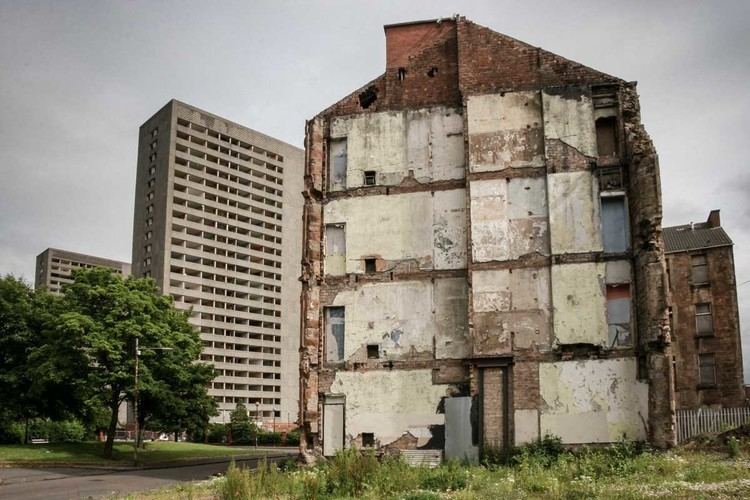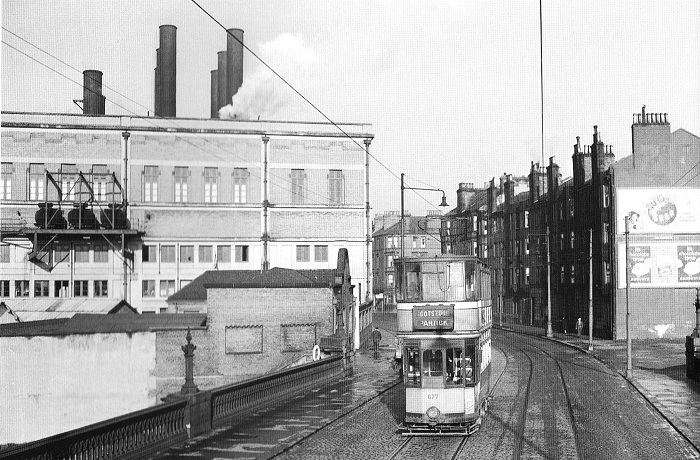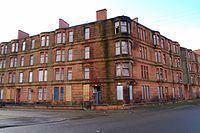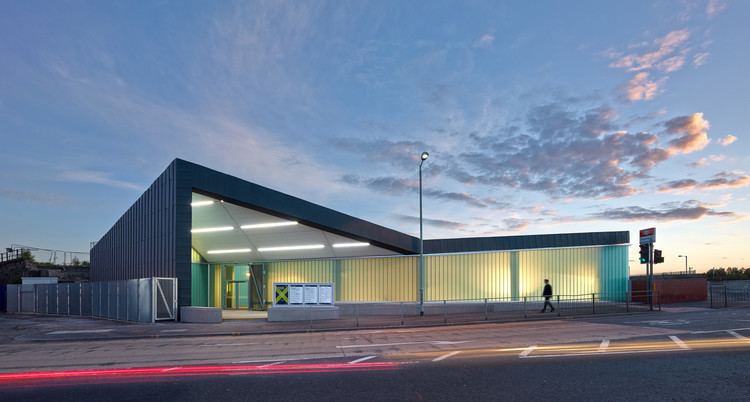OS grid reference NS611630 Sovereign state United Kingdom Postcode district G40 Dialling code 0141 | Post town GLASGOW | |
 | ||
Dalmarnock (Scottish Gaelic: Dail Mheàrnaig) is a district in the Scottish city of Glasgow. It is situated north of the River Clyde opposite the town of Rutherglen. It is bounded by the Clyde to the south and east, Parkhead to the north, and Bridgeton at Dunn Street to the north west. The area covers part of a loop in the River Clyde called the Cuningar Loop (known locally as 'The Vallies').
Contents
- Dalmarnock flat demolition
- Dalmarnock Bridge
- Dalmarnock Railway Bridges
- History
- Rail
- Education
- Commonwealth Games
- Notable people
- References

Dalmarnock flat demolition
Dalmarnock Bridge

There is a bridge over the River Clyde on Dalmarnock Road (A749) called Dalmarnock Bridge. The first bridge in the area was a wooden one erected in 1821 to connect Dalmarnock and the Farme Cross area of Rutherglen. It was replaced by a new timber bridge in 1848, and in 1891 by the current Dalmarnock Bridge, designed by Glasgow consulting engineers, Crouch & Hogg.

The Glasgow side of the bridge is a convenient point for walkers and cyclists to join the Clyde Walkway or National Cycle Route 75 which share a tarmac path along the river at this point.
It should not be confused with the nearby Rutherglen Bridge which also connects Rutherglen (Shawfield) to Dalmarnock as well as Glasgow Green and Bridgeton, nor with a modern pedestrian 'Smartbridge' between Shawfield and Dalmarnock.
Dalmarnock Railway Bridges

There have also been two railway bridges in Dalmarnock crossing the River Clyde. The first bridge was built in 1861, but was soon replaced in 1897 by a wider bridge to accommodate the Dalmarnock branch line. The stone pillars of the old bridge are still in situ adjacent to the newer bridge. Both bridges were designed by George Graham.
History

The area was once heavily industrialised. Sir William Arrol & Co. had its extensive engineering works at Dunn Street and Baltic Street from 1873. From its beginnings in boiler making, the firm later became renowned for its achievements in the field of Structural engineering. Amongst the many bridges constructed throughout Britain were the Forth Railway Bridge and Forth Road Bridge, the Humber Bridge and London's Tower Bridge. The company was eventually taken over by Clarke Chapman in 1969 and the Dalmarnock Works closed in 1986. There was also a large coal-fired power station located near Dalmarnock Bridge. It was built by Glasgow Corporation in two stages, with phase one opening in 1920 and phase two in 1926. It was closed in 1977 by the South of Scotland Electricity Board.
The east side of Allan Street was bombed during the Second World War. Most of the Victorian red-sandstone tenements on Dalmarnock Road and Springfield Road were demolished in the '60s and early '70s, although some were renovated. Springfield Road remains the centre of the community, with several retailers and small businesses. In the 1960s, a new housing scheme was built, consisting of four twenty-two storey tower blocks and 'H-block' maisionettes. Two of the towers, 40 & 50 Millerfield Road, were demolished on 3 February 2002. One other tower was demolished on 1 July 2007, and the final one on 9 September 2007.
Dalmarnock now, August 2011, has no housing on Ardenlea St / Sunnybank St side of the area, due to the construction in the area pertaining to the Commonwealth Games and City Legacy.
After the departure of all local retailers from the area all that remains is a small shop which was set up by the workers in the Community Centre. This has been a welcome boon for the area residents as the nearest shops are not within walking distance. There is a petrol station on Dalmarnock Road and a car wash. There are also a lot of small business units in the Nuneaton Street area and Calder Millerfield which supplies meat based products to the fast food market.
Rail
Dalmarnock railway station, on the Argyle Line, serves the local area.
Dalmarnock Railway Station was upgraded for the 2014 Commonwealth Games.
Education
The area used to have four schools: Springfield Road Primary, Springfield Primary, Riverside Secondary and Our Lady of Fatima RC Primary School on Springfield Road have now closed. There is a Dalmarnock Primary School situated in the nearby Bridgeton area of the East End of Glasgow and should not be counted in the schools list for the area.
Commonwealth Games
Dalmarnock is the location for the athletes' village when Glasgow hosts the 2014 Commonwealth Games and proposed skyscraper East One.
The Sir Chris Hoy Velodrome is also in the area, at the section of Springfield Road where it intersects London Road.
From 19 May 2014 to 2 June 2014 BBC One Scotland aired a documentary entitled "Commonwealth City" which showed how the people and community in Dalmarnock have been affected since the games were announced in November 2007. It was narrated by actor Martin Compston.
